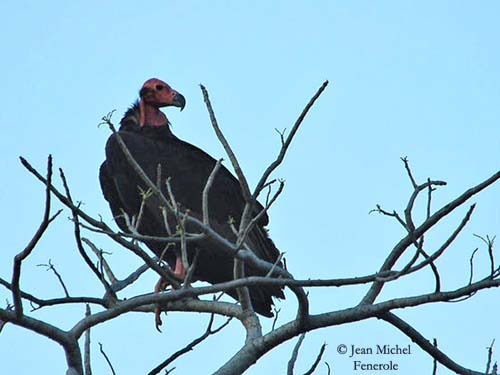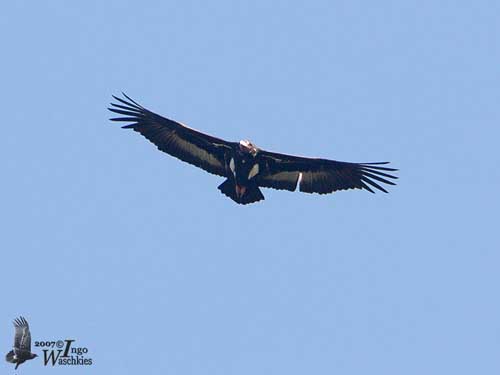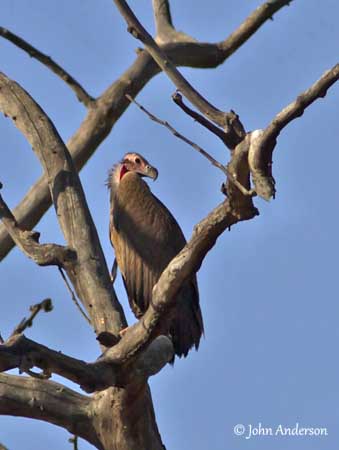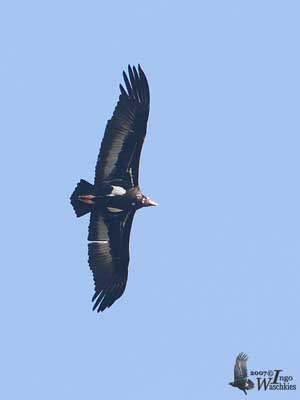Post by OldGreenVulture on Jul 28, 2019 14:26:23 GMT
Red-headed Vulture
Sarcogyps calvus
Accipitriforme Order – Accipitridae Family
BIOMETRICS:
Length: 76-84 cm
Wingspan: 220-230 cm
Weight: 3600-5400 g
DESCRIPTION:
The Red-headed Vulture was formerly widespread in India and south-eastern Asia, but after massive decline probably due to the veterinary drug Diclofenac ingested with the carcasses of livestock, this species is today Critically Endangered.
This is a medium-sized raptor, the only member of the genus Sarcogyps.
It has black plumage overall.
The black body shows white patches on the flanks above the thighs, with bare red patches in the middle of each white patch.
The brownish crop has red bare patches on each side, and the deep red bare upper neck shows two broad lappets on the sides.
At the base of the neck, we can see a ruff of blackish-brown feathers on the hind neck and the sides, and white on the breast sides and the upper breast around the crop.
On the upperwing, we can see a pale buffy-grey band across the base of the flight feathers. The tapered wing shape is distinctive and well visible in flight.
On the bare red head, some sparse black down can be visible on crown, nape and lower cheek area.
The strong bill is black with red cere. The eyes are yellowish to white in male. Legs and feet are deep red.

Both sexes are similar, but the female has dark brown eyes.
The juvenile has dark brown plumage with pale-edged feathers. The eyes are dark brown. The bare parts are duller than in adults.
VOICE:
The Red-headed Vulture only utters grunts, croaks and hisses, especially around the carcasses.
HABITAT:
The Red-headed Vulture frequents open countryside, even near human habitation, cultivated areas, well-wooded hills, savannah woodland and dry deciduous forests but often below 2000-2500 metres of elevation.
RANGE:
The Red-headed Vulture has today more restricted range. This species is sedentary and occurs primarily in Nepal and Northern India.
It is sparsely distributed in India, but remains fairly common in the foothills of the Himalayas. However, it is uncommon is the most part of the range.
BEHAVIOUR:
The Red-headed Vulture often feeds on carrion, and can be seen at carcasses of large mammals such as ungulates, but also birds, turtles and fish. Around the larger carcasses, it feeds with other vultures’ species. It is rather timid when feeding, but with the dramatic declines of the Gyps vultures, the Red-headed Vulture is today more present and at better places.

This vulture also steals food from other vultures, especially from the Egyptian Vulture, but probably from other raptors too.
The Red-headed Vulture is more often seen alone or in pairs than in groups like other species.
Male and female performs acrobatic aerial displays in spite of their size. Both mates soar together and perform mutual cartwheeling displays on the ground.
Once the pair is formed, it becomes territorial and chases away all other vultures from the territory.
This species nests in trees or bushes as the Lappet-faced Vulture.
VOL:
The Red-headed Vulture soars in thermals. Its large tapered wings are very distinctive in flight.
REPRODUCTION:
The breeding season occurs between December and April.
Both mates build a large nest in tall tree, at 9-12 metres above the ground, often at treetop.
In more desert areas, they nest on top of bushes, at 2-3 metres height.
The flat nest is made with sticks, and lined with green leaves and dry grass.
The female lays a single egg. Both parents incubate during 45 days. At hatching, the chick is covered in greyish-white down.
Fledging and dependency periods are unknown.

DIET:
The Red-headed Vulture feeds mainly on carrion at carcasses of large ungulates, birds, turtles and fish.
It also pirates food from other raptors.
PROTECTION / THREATS / STATUS:
The Red-headed Vulture is threatened by the more reduced populations of large ungulates due to hunting pressure. They also suffer hunting, disease and direct persecution.
But the main cause of these dramatic declines is the consumption of livestock treated with the Diclofenac, a veterinary drug used in domestic animals.
The huge decline of vultures of genus Gyps is also mainly due to this drug.
Today, the Red-headed Vulture has easier access to carcasses with less Gyps vultures than formerly for dominance over him, and finally, it is now at the best places to consume this drug.
The species is classified as Critically Endangered.

Sarcogyps calvus
Accipitriforme Order – Accipitridae Family
BIOMETRICS:
Length: 76-84 cm
Wingspan: 220-230 cm
Weight: 3600-5400 g
DESCRIPTION:
The Red-headed Vulture was formerly widespread in India and south-eastern Asia, but after massive decline probably due to the veterinary drug Diclofenac ingested with the carcasses of livestock, this species is today Critically Endangered.
This is a medium-sized raptor, the only member of the genus Sarcogyps.
It has black plumage overall.
The black body shows white patches on the flanks above the thighs, with bare red patches in the middle of each white patch.
The brownish crop has red bare patches on each side, and the deep red bare upper neck shows two broad lappets on the sides.
At the base of the neck, we can see a ruff of blackish-brown feathers on the hind neck and the sides, and white on the breast sides and the upper breast around the crop.
On the upperwing, we can see a pale buffy-grey band across the base of the flight feathers. The tapered wing shape is distinctive and well visible in flight.
On the bare red head, some sparse black down can be visible on crown, nape and lower cheek area.
The strong bill is black with red cere. The eyes are yellowish to white in male. Legs and feet are deep red.

Both sexes are similar, but the female has dark brown eyes.
The juvenile has dark brown plumage with pale-edged feathers. The eyes are dark brown. The bare parts are duller than in adults.
VOICE:
The Red-headed Vulture only utters grunts, croaks and hisses, especially around the carcasses.
HABITAT:
The Red-headed Vulture frequents open countryside, even near human habitation, cultivated areas, well-wooded hills, savannah woodland and dry deciduous forests but often below 2000-2500 metres of elevation.
RANGE:
The Red-headed Vulture has today more restricted range. This species is sedentary and occurs primarily in Nepal and Northern India.
It is sparsely distributed in India, but remains fairly common in the foothills of the Himalayas. However, it is uncommon is the most part of the range.
BEHAVIOUR:
The Red-headed Vulture often feeds on carrion, and can be seen at carcasses of large mammals such as ungulates, but also birds, turtles and fish. Around the larger carcasses, it feeds with other vultures’ species. It is rather timid when feeding, but with the dramatic declines of the Gyps vultures, the Red-headed Vulture is today more present and at better places.

This vulture also steals food from other vultures, especially from the Egyptian Vulture, but probably from other raptors too.
The Red-headed Vulture is more often seen alone or in pairs than in groups like other species.
Male and female performs acrobatic aerial displays in spite of their size. Both mates soar together and perform mutual cartwheeling displays on the ground.
Once the pair is formed, it becomes territorial and chases away all other vultures from the territory.
This species nests in trees or bushes as the Lappet-faced Vulture.
VOL:
The Red-headed Vulture soars in thermals. Its large tapered wings are very distinctive in flight.
REPRODUCTION:
The breeding season occurs between December and April.
Both mates build a large nest in tall tree, at 9-12 metres above the ground, often at treetop.
In more desert areas, they nest on top of bushes, at 2-3 metres height.
The flat nest is made with sticks, and lined with green leaves and dry grass.
The female lays a single egg. Both parents incubate during 45 days. At hatching, the chick is covered in greyish-white down.
Fledging and dependency periods are unknown.

DIET:
The Red-headed Vulture feeds mainly on carrion at carcasses of large ungulates, birds, turtles and fish.
It also pirates food from other raptors.
PROTECTION / THREATS / STATUS:
The Red-headed Vulture is threatened by the more reduced populations of large ungulates due to hunting pressure. They also suffer hunting, disease and direct persecution.
But the main cause of these dramatic declines is the consumption of livestock treated with the Diclofenac, a veterinary drug used in domestic animals.
The huge decline of vultures of genus Gyps is also mainly due to this drug.
Today, the Red-headed Vulture has easier access to carcasses with less Gyps vultures than formerly for dominance over him, and finally, it is now at the best places to consume this drug.
The species is classified as Critically Endangered.


